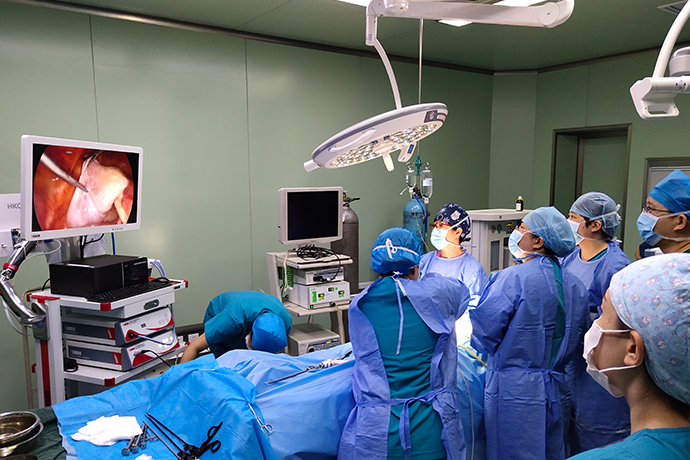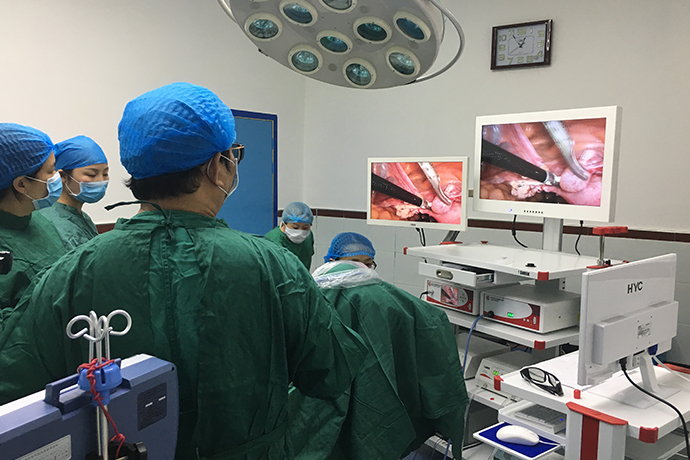【Gynecological Laparoscopy】Fallopian Tube Clamping
Release time: 17 Aug 2021 Author:Shrek
At present, most literature reports that untreated hydrosalpinx has a negative impact on the outcome of IVF-ET, which leads to a decrease in embryo implantation rate, a decrease in clinical pregnancy rate and an increase in abortion rate.
The possible reasons are: ①The hydrosalpinx can flow back into the uterine cavity to flush out the embryo, and the water present on the surface of the endometrium interferes with the interaction between the endometrium and the embryo and inhibits embryo implantation. ②Inflammatory hydrosalpinx impairs endometrial receptivity. ③Hydrosalpinx is often caused by pathogen infection. The fallopian tube clamp not only blocks the influence and toxic effects of hydrosalpinx on embryo implantation, but also avoids the possibility of damaging the mesangial blood vessels and affecting the blood supply of the ovaries when the fallopian tube is removed.

Indications
1. Hydrosalpinx before IVF-ET is the most important indication for tubal clamp surgery.
2. Patients who voluntarily undergo tubal sterilization.
Surgical steps and techniques
1. Take the bladder lithotomy position, routinely disinfect the drape, establish pneumoperitoneum, and place the endoscope.
2. Under the laparoscopy, understand the pelvic condition and separate the pelvic adhesions.
3. Fallopian tube stoma and tubal fimbriaplasty (this step is the same as tubal plastic ostomy).
4. Fallopian tube clamp surgery reveals the clamp sites of both fallopian tubes, use non-invasive forceps to lift and fix the wall of the isthmus of the fallopian tube, implant a titanium clamp, double clamp the fallopian tube at the proximal end of the left fallopian tube isthmus, and press hard to facilitate the closure of the lumen . Treat the opposite side in the same way.
Intraoperative risks and prevention
1. Wound bleeding Wound bleeding may occur during the separation of adhesions. Try to choose the avascular area to cut with electrocoagulation shears or separate with bipolar electric hooks. If the adhesion is thick or there are blood vessels, it can be cut off after electrocoagulation. The broken ends after separation should be carefully checked and electrocoagulated to stop bleeding.
2. Fallopian tube injury or breakage. Apparatus should be used reasonably during the process of separating the adhesions around the fallopian tube, try to avoid thermoelectric damage to the fallopian tube, and try to avoid forced tearing of the fallopian tube during the plastic stoma.
3. Titanium clips cannot be placed if they are unsatisfactory or fail to be placed around the fallopian tube if the adhesion around the fallopian tube is severe or the fallopian tube is obviously thickened and hardened. It must be changed to other methods such as electrocoagulation of the proximal fallopian tube.
4. If you accidentally clamp the round ligament of the uterus or the proper ovarian ligament due to adhesion changes or the visual field is not clear, you may accidentally clamp the round ligament of the uterus or the proper ovary ligament.
5. After the titanium clip is displaced, loosened or fallen off, the position of the titanium clip and the clamping effect should be carefully observed. If the titanium clip is found to be displaced, loosened or fallen off, it should be replaced in time and the operation should be repeated.
Precautions after operation
1. When the re-adhesion of the pelvic and abdominal cavity and around the fallopian tube is completed, the pelvic and abdominal cavity should be flushed with normal saline or dexamethasone; the adhesion wound is coated with sodium hyaluronate gel to prevent the recurrence of adhesions; it is also possible to encourage the patient to get out of bed early after the operation Reduce the risk of re-adhesion.
2. Loss of natural fertility requires full informed consent before tubal clamp surgery. Natural fertility will be lost after the fallopian tube is clamped.
3. Fallopian tube recanalization. If the fallopian tube wall is thickened or thickened or the titanium clip falls off, the fallopian tube may recanalize after the operation, and the possibility of occurrence of tubal interstitial pregnancy or corneal pregnancy will increase.
4. For chronic pelvic pain, if too much mesangial tissue is clamped, it may affect the blood supply of the ovaries and cause postoperative pain symptoms.
5. Strengthen propaganda and education and guide patients' pregnancy methods, and inform them to adopt assisted reproductive methods as soon as possible. However, sexual life is prohibited within 2 weeks after surgery, and heavy physical labor or strenuous exercise should be avoided.

The possible reasons are: ①The hydrosalpinx can flow back into the uterine cavity to flush out the embryo, and the water present on the surface of the endometrium interferes with the interaction between the endometrium and the embryo and inhibits embryo implantation. ②Inflammatory hydrosalpinx impairs endometrial receptivity. ③Hydrosalpinx is often caused by pathogen infection. The fallopian tube clamp not only blocks the influence and toxic effects of hydrosalpinx on embryo implantation, but also avoids the possibility of damaging the mesangial blood vessels and affecting the blood supply of the ovaries when the fallopian tube is removed.

Indications
1. Hydrosalpinx before IVF-ET is the most important indication for tubal clamp surgery.
2. Patients who voluntarily undergo tubal sterilization.
Surgical steps and techniques
1. Take the bladder lithotomy position, routinely disinfect the drape, establish pneumoperitoneum, and place the endoscope.
2. Under the laparoscopy, understand the pelvic condition and separate the pelvic adhesions.
3. Fallopian tube stoma and tubal fimbriaplasty (this step is the same as tubal plastic ostomy).
4. Fallopian tube clamp surgery reveals the clamp sites of both fallopian tubes, use non-invasive forceps to lift and fix the wall of the isthmus of the fallopian tube, implant a titanium clamp, double clamp the fallopian tube at the proximal end of the left fallopian tube isthmus, and press hard to facilitate the closure of the lumen . Treat the opposite side in the same way.
Intraoperative risks and prevention
1. Wound bleeding Wound bleeding may occur during the separation of adhesions. Try to choose the avascular area to cut with electrocoagulation shears or separate with bipolar electric hooks. If the adhesion is thick or there are blood vessels, it can be cut off after electrocoagulation. The broken ends after separation should be carefully checked and electrocoagulated to stop bleeding.
2. Fallopian tube injury or breakage. Apparatus should be used reasonably during the process of separating the adhesions around the fallopian tube, try to avoid thermoelectric damage to the fallopian tube, and try to avoid forced tearing of the fallopian tube during the plastic stoma.
3. Titanium clips cannot be placed if they are unsatisfactory or fail to be placed around the fallopian tube if the adhesion around the fallopian tube is severe or the fallopian tube is obviously thickened and hardened. It must be changed to other methods such as electrocoagulation of the proximal fallopian tube.
4. If you accidentally clamp the round ligament of the uterus or the proper ovarian ligament due to adhesion changes or the visual field is not clear, you may accidentally clamp the round ligament of the uterus or the proper ovary ligament.
5. After the titanium clip is displaced, loosened or fallen off, the position of the titanium clip and the clamping effect should be carefully observed. If the titanium clip is found to be displaced, loosened or fallen off, it should be replaced in time and the operation should be repeated.
Precautions after operation
1. When the re-adhesion of the pelvic and abdominal cavity and around the fallopian tube is completed, the pelvic and abdominal cavity should be flushed with normal saline or dexamethasone; the adhesion wound is coated with sodium hyaluronate gel to prevent the recurrence of adhesions; it is also possible to encourage the patient to get out of bed early after the operation Reduce the risk of re-adhesion.
2. Loss of natural fertility requires full informed consent before tubal clamp surgery. Natural fertility will be lost after the fallopian tube is clamped.
3. Fallopian tube recanalization. If the fallopian tube wall is thickened or thickened or the titanium clip falls off, the fallopian tube may recanalize after the operation, and the possibility of occurrence of tubal interstitial pregnancy or corneal pregnancy will increase.
4. For chronic pelvic pain, if too much mesangial tissue is clamped, it may affect the blood supply of the ovaries and cause postoperative pain symptoms.
5. Strengthen propaganda and education and guide patients' pregnancy methods, and inform them to adopt assisted reproductive methods as soon as possible. However, sexual life is prohibited within 2 weeks after surgery, and heavy physical labor or strenuous exercise should be avoided.

- Recommended news
- 【General Surgery Laparoscopy】Cholecystectomy
- Surgery Steps of Hysteroscopy for Intrauterine Adhesion
- [Gynecological Hysteroscopy] Techniques for Preventing and Treating Complications of Hysteroscopic Surgery
- [Gynecological Hysteroscopy] Hysteroscopic Adhesiolysis
- [Gynecological Hysteroscopy] IUD Removal under Hysteroscopy